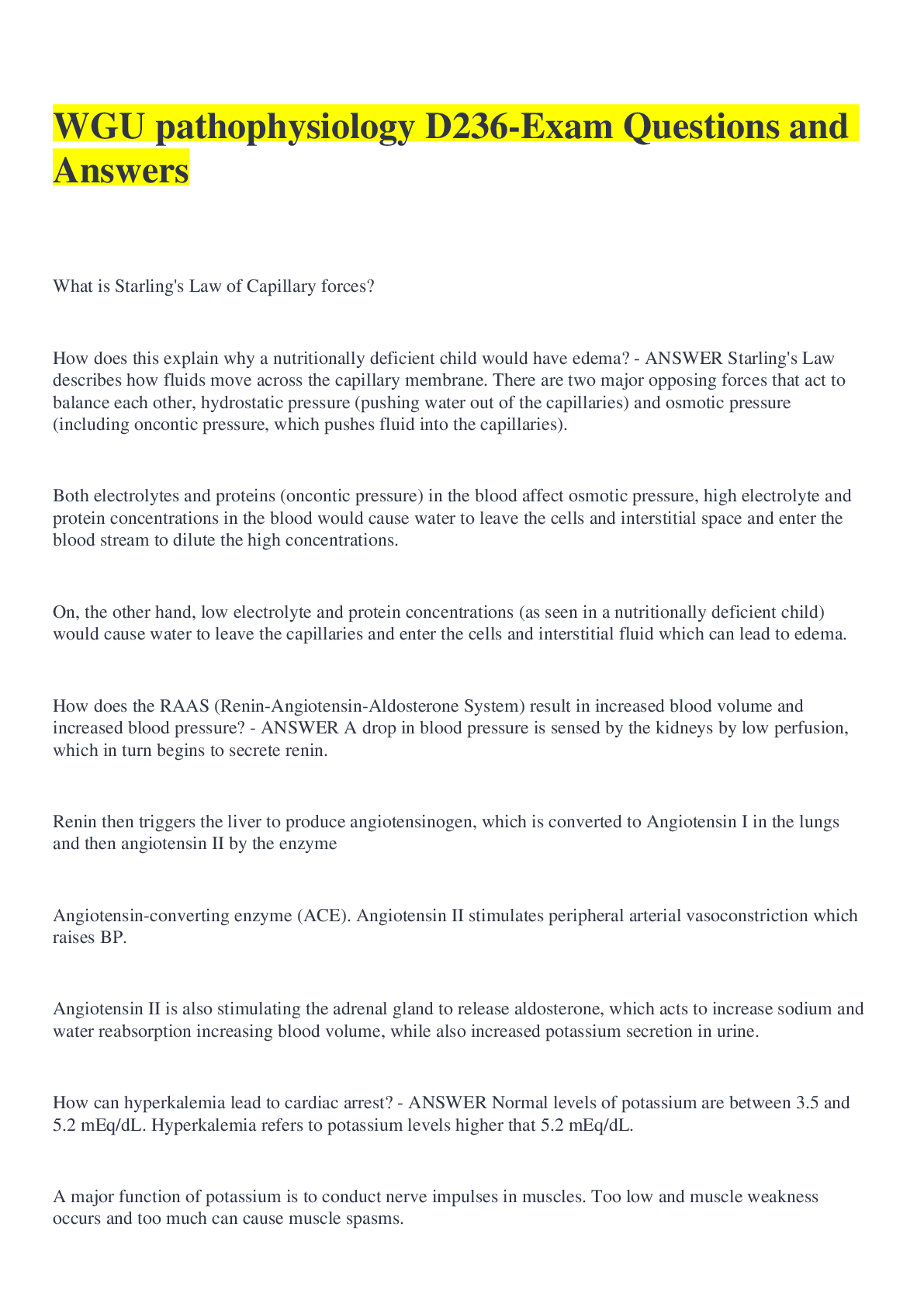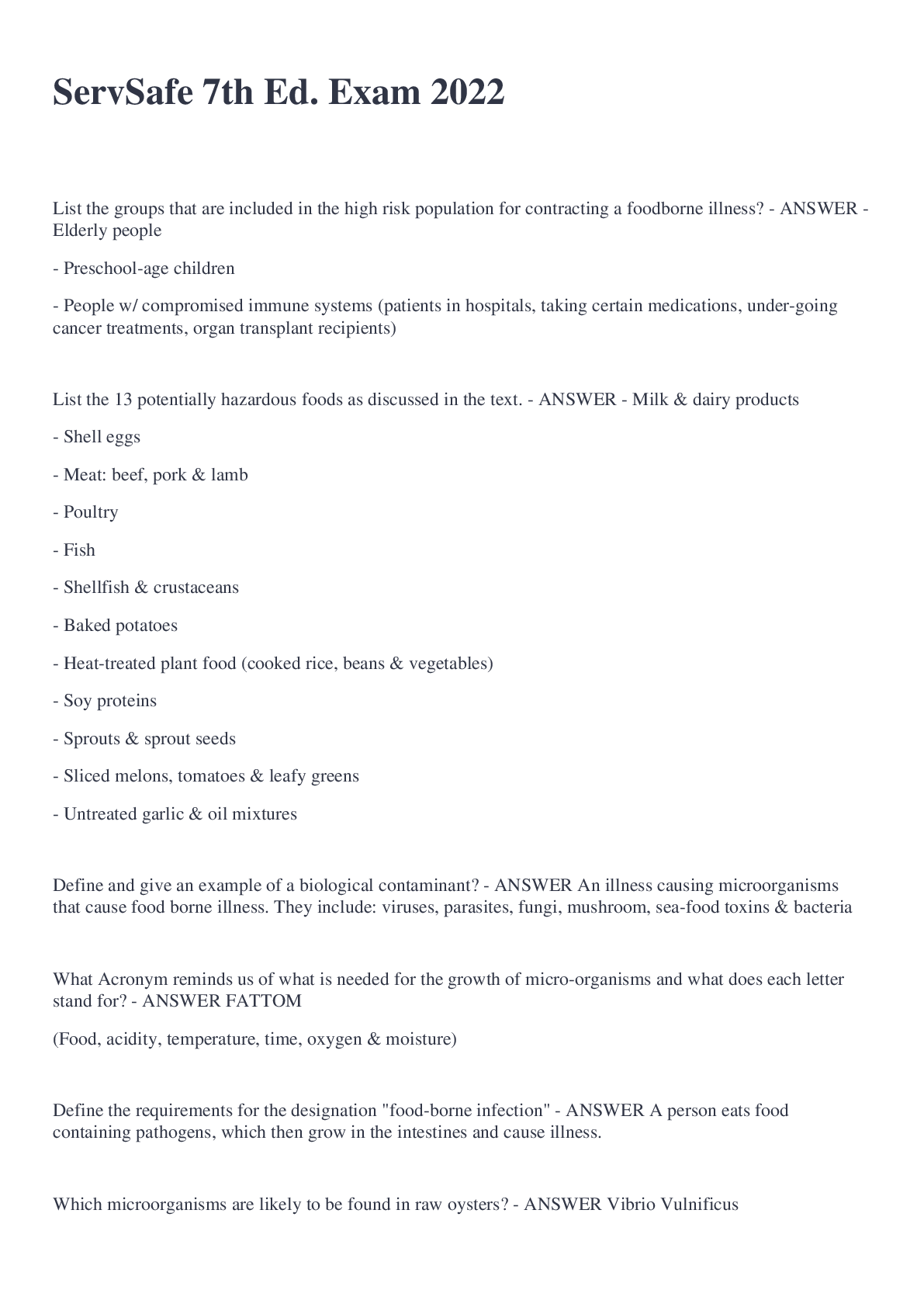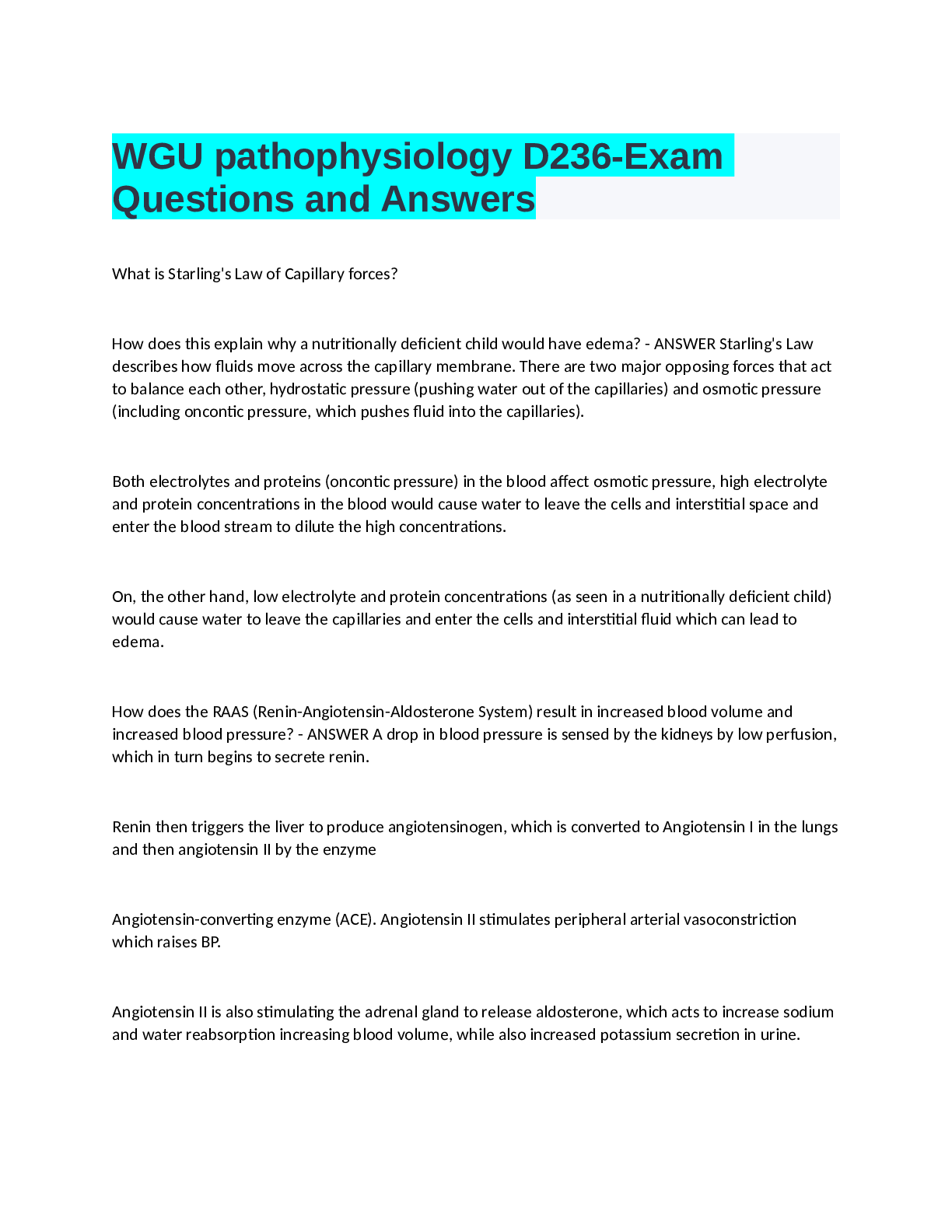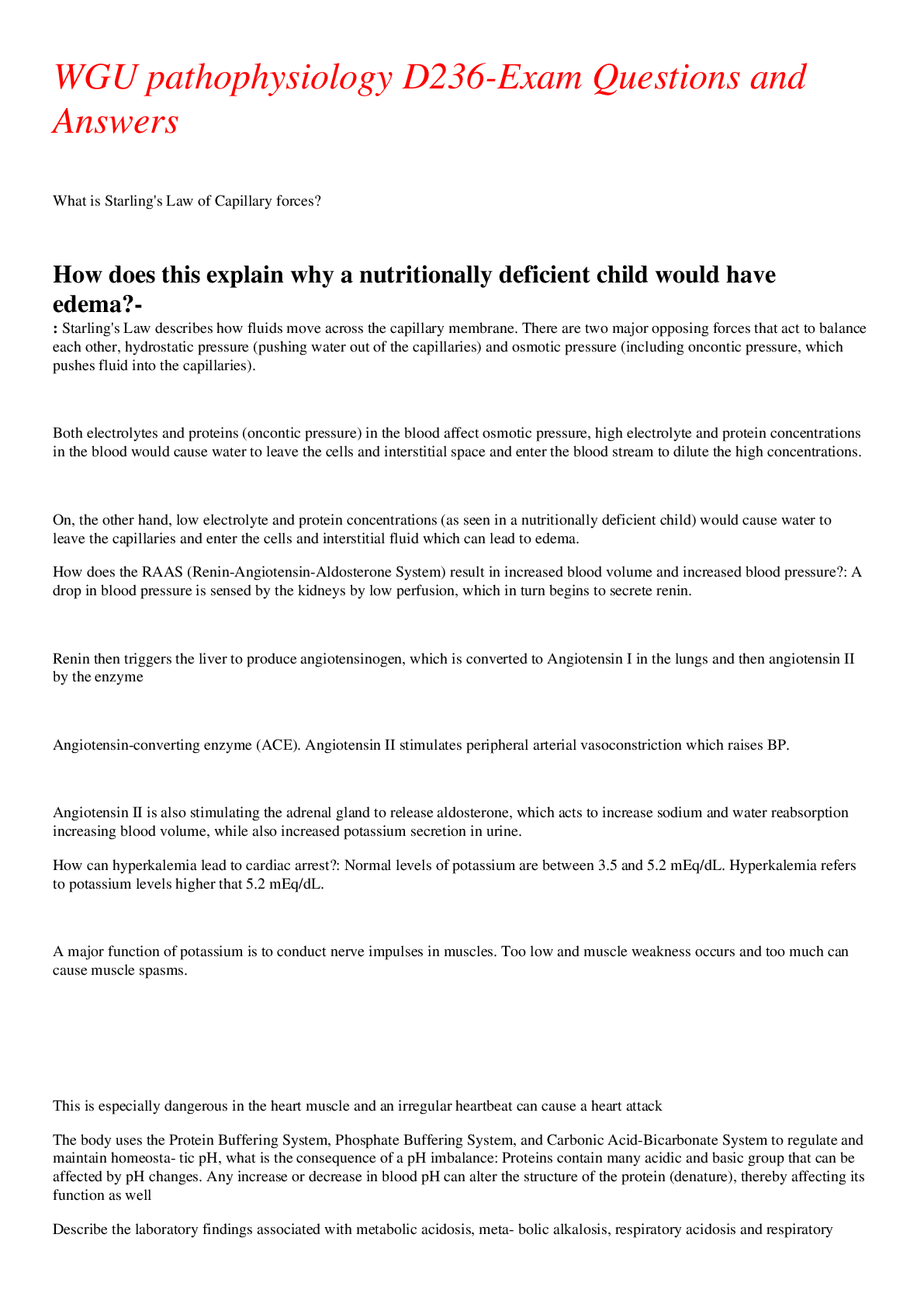WGU pathophysiology D236-Exam Questions and Answers
Document Content and Description Below
What is Starling's Law of Capillary forces? How does this explain why a nutritionally deficient child would have edema? - ANSWER Starling's Law describes how fluids move across the capillary membr... ane. There are two major opposing forces that act to balance each other, hydrostatic pressure (pushing water out of the capillaries) and osmotic pressure (including oncontic pressure, which pushes fluid into the capillaries). Both electrolytes and proteins (oncontic pressure) in the blood affect osmotic pressure, high electrolyte and protein concentrations in the blood would cause water to leave the cells and interstitial space and enter the blood stream to dilute the high concentrations. On, the other hand, low electrolyte and protein concentrations (as seen in a nutritionally deficient child) would cause water to leave the capillaries and enter the cells and interstitial fluid which can lead to edema. How does the RAAS (Renin-Angiotensin-Aldosterone System) result in increased blood volume and increased blood pressure? - ANSWER A drop in blood pressure is sensed by the kidneys by low perfusion, which in turn begins to secrete renin. Renin then triggers the liver to produce angiotensinogen, which is converted to Angiotensin I in the lungs and then angiotensin II by the enzyme Angiotensin-converting enzyme (ACE). Angiotensin II stimulates peripheral arterial vasoconstriction which raises BP. Angiotensin II is also stimulating the adrenal gland to release aldosterone, which acts to increase sodium and water reabsorption increasing blood volume, while also increased potassium secretion in urine. How can hyperkalemia lead to cardiac arrest? - ANSWER Normal levels of potassium are between 3.5 and 5.2 mEq/dL. Hyperkalemia refers to potassium levels higher that 5.2 mEq/dL. A major function of potassium is to conduct nerve impulses in muscles. Too low and muscle weakness occurs and too much can cause muscle spasms. This is especially dangerous in the heart muscle and an irregular heartbeat can cause a heart attack The body uses the Protein Buffering System, Phosphate Buffering System, and Carbonic Acid-Bicarbonate System to regulate and maintain homeostatic pH, what is the consequence of a pH imbalance - ANSWER Proteins contain many acidic and basic group that can be affected by pH changes. Any increase or decrease in blood pH can alter the structure of the protein (denature), thereby affecting its function as well Describe the laboratory findings associated with metabolic acidosis, metabolic alkalosis, respiratory acidosis and respiratory alkalosis. (ie relative pH and CO2 levels). - ANSWER Normal ABGs (Arterial Blood Gases) Blood pH: 7.35-7.45 PCO2: 35-45 mm Hg PO2: 90-100 mm Hg HCO3-: 22-26 mEq/L SaO2: 95-100% Respiratory acidosis and alkalosis are marked by changes in PCO2. Higher = acidosis and lower = alkalosis Metabolic acidosis and alkalosis are caused by something other than abnormal CO2 levels. This could include toxicity, diabetes, renal failure or excessive GI losses. Here are the rules to follow to determine if is respiratory or metabolic in nature. -If pH and PCO2 are moving in opposite directions, then it is the pCO2 levels that are causing the imbalance and it is respiratory in nature. -If PCO2 is normal or is moving in the same direction as the pH, then the imbalance is metabolic in nature. The anion gap is the difference between measured cations (Na+ and K+) and measured anions (Cl- and HCO3-), this calculation can be useful in determining the cause of metabolic acidosis. Why would an increased anion gap be observed in diabetic ketoacidosis or lactic acidosis? - ANSWER The anion gap is the calculation of unmeasured anions in the blood. Lactic acid and ketones both lead to the production of unmeasured anions, which remove HCO3- (a measured anion) due to buffering of the excess H+ and therefore leads to an increase in the AG. Why is it important to maintain a homeostatic balance of glucose in the blood (ie describe the pathogenesis of diabetes)? - ANSWER Insulin is the hormone responsible for initiating the uptake of glucose by the cells. Cells use glucose to produce energy (ATP). In a normal individual, when blood glucose increases, the pancreas is signaled to produced in insulin, which binds to insulin receptors on a cells surface and initiates the uptake of glucose. Glucose is a very reactive molecule and if left in the blood, it can start to bind to other proteins and lipids, which can lead to loss of function. AGEs are advanced glycation end products that are a result of glucose reacting with the endothelial lining, which can lead to damage in the heart and kidneys. Compare and contrast Type I and Type II Diabetes - ANSWER Type I diabetes is caused by lack of insulin. With out insulin signaling, glucose will not be taken into the cell and leads to high blood glucose (hyperglycemia). Type I is usually treated with insulin injections. Type II diabetes is caused by a desensitization to insulin signaling. The insulin receptors are no longer responding to insulin, which also leads to hyperglycemia. Type II is usually treated with drugs to increase the sensitization to insulin (metformin), dietary and life-style changes or insulin injections. Describe some reasons for a patient needing dialysis - ANSWER AEIOU-acidosis. Electrolytes, Intoxication/Ingestion, overload, uremia. Patients with kidney or heart failure. A build up of phosphates, urea and magnesium are removed from the blood using a semi-permeable membrane and dialysate. AEIOU: A—acidosis; E—electrolytes principally hyperkalemia; I—ingestions or overdose of medications/drugs; O—overload of fluid causing heart failure; U—uremia leading to encephalitis/pericarditis Compare and contrast hemodialysis and peritoneal dialysis. What are some reasons for a patient choosing one over the other? - ANSWER Hemodialysis uses a machine to pump blood from the body in one tube while dialysate (made of water, electrolytes and salts) is pumped in the separate tube in the opposite direction. Waste from the blood diffuses through the semipermeable membrane separating the blood from the dialysate. Peritoneal Dialysis does not use a machine, but instead injects a solution of water and glucose into the abdominal cavity. The peritoneum acts as the membrane instead of dialysis tubing. The waste products diffuse into the abdominal cavity and the waste solution is then drained from the body. Peritoneal dialysis offers continuous filtration and is less disruption to the patient's daily routines. However, it does require some training of the patient and is not recommended for individuals who are overweight or have severe kidney failure. Hemodialysis provides medical care, but 3 times a week for several hours sitting at a hospital or clinic. Individuals with acute kidney failure are recommended to use hemodialysis. How does homeostasis and maintaining optimal physiological health impact your wellbeing? - ANSWER Homeostasis acts to create a constant and stable environment in the body despite internal and external changes. Proteins and other cellular processes require optimal conditions in order to carry out their functions. Alterations in pH, salt concentration, temperature, glucose levels, etc. can have negative effects on health, so it is vital for mechanisms that regulate homeostasis to function properly for maintaining good health Differentiate between Innate Immunity and Adaptive Immunity ? - ANSWER The innate immune system encompasses physical barriers and chemical and cellular defenses. Physical barriers protect the body from invasion. These include things like the skin and eyelashes. Chemical barriers are defense mechanisms that can destroy harmful agent. Examples include tears, mucous, and stomach acid. Cellular defenses of the innate immune response are non-specific. These cellular defenses identify pathogens and substances that are potentially dangerous and takes steps to neutralize or destroy them. Adaptive immunity is an organism's acquired immunity to a specific pathogen. As such, it's also referred to as acquired immunity. Adaptive immunity is not immediate, nor does it always last throughout an organism's entire lifespan, alt [Show More]
Last updated: 1 year ago
Preview 1 out of 36 pages

Buy this document to get the full access instantly
Instant Download Access after purchase
Add to cartInstant download
We Accept:

Reviews( 0 )
$10.00
Document information
Connected school, study & course
About the document
Uploaded On
Oct 21, 2022
Number of pages
36
Written in
Additional information
This document has been written for:
Uploaded
Oct 21, 2022
Downloads
0
Views
258











.png)





